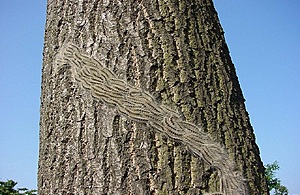As Oak Processionary Moth season begins, the Forestry Commission reminds people to be aware of the pest and report sightings
The public is being urged to report sightings of the tree pest Oak Processionary Moth (OPM) caterpillars.
Oak Processionary Moth was first identified in London in 2006 and has since spread to some surrounding counties. The caterpillars and their nests contain hairs which can cause itchy rashes, eye and throat irritations, and should not be touched under any circumstances at any time. The greatest risk period is May to July when the caterpillars emerge and feed before pupating into adult moths.
OPM caterpillars feed on oak leaves and can increase trees’ vulnerability to attack by other pests and diseases, making them less able to withstand adverse weather conditions such as drought and floods. A government programme is in place to limit their spread from areas where they are present.
The pest is established in London and surrounding areas but the majority of the country is designated a Protected Zone, which means it is free from the pest.
The Forestry Commission, working in partnership with others, have an annual programme in place to tackle the pest, with an ongoing programme of surveillance, treatment and research.
Andrew Hall, Forestry Commission Operations Manager, said:
At this time of year, many people are enjoying green spaces and it’s really important for the public to be aware of the risk of tree pests like Oak Processionary Moth and to report any sightings via our TreeAlert website or by calling the Forestry Commission. This will help us with our programme of treatment and enables us to slow the spread of this pest.
Any sightings should be reported to the Forestry Commission via its Tree Alert online portal. Alternatively, people can email opm@forestrycommission.gov.uk or call 0300 067 4442.
Since 2012, the government has invested more than £37 million in tree health research; this includes a dedicated programme of research on oaks and the pests that threaten them, such as Oak Processionary Moth.
The Government has also introduced tighter biosecurity checks at the border, and in 2019 introduced further restrictions on the import of oak trees to England following a number of interceptions of the pest.
How to identify OPM caterpillars
Nests are typically dome or teardrop-shaped, averaging the size of a tennis ball. They are white when fresh, but soon become discoloured and brown. The caterpillars have black heads and bodies covered in long white hairs which contain proteins which can cause itchy rashes, eye, and throat irritations. They can also occasionally cause breathing difficulties in people and pets, so should not be touched under any circumstances.
For more information on how to identify OPM, including common mistaken species, visit www.forestresearch.gov.uk/opm.



